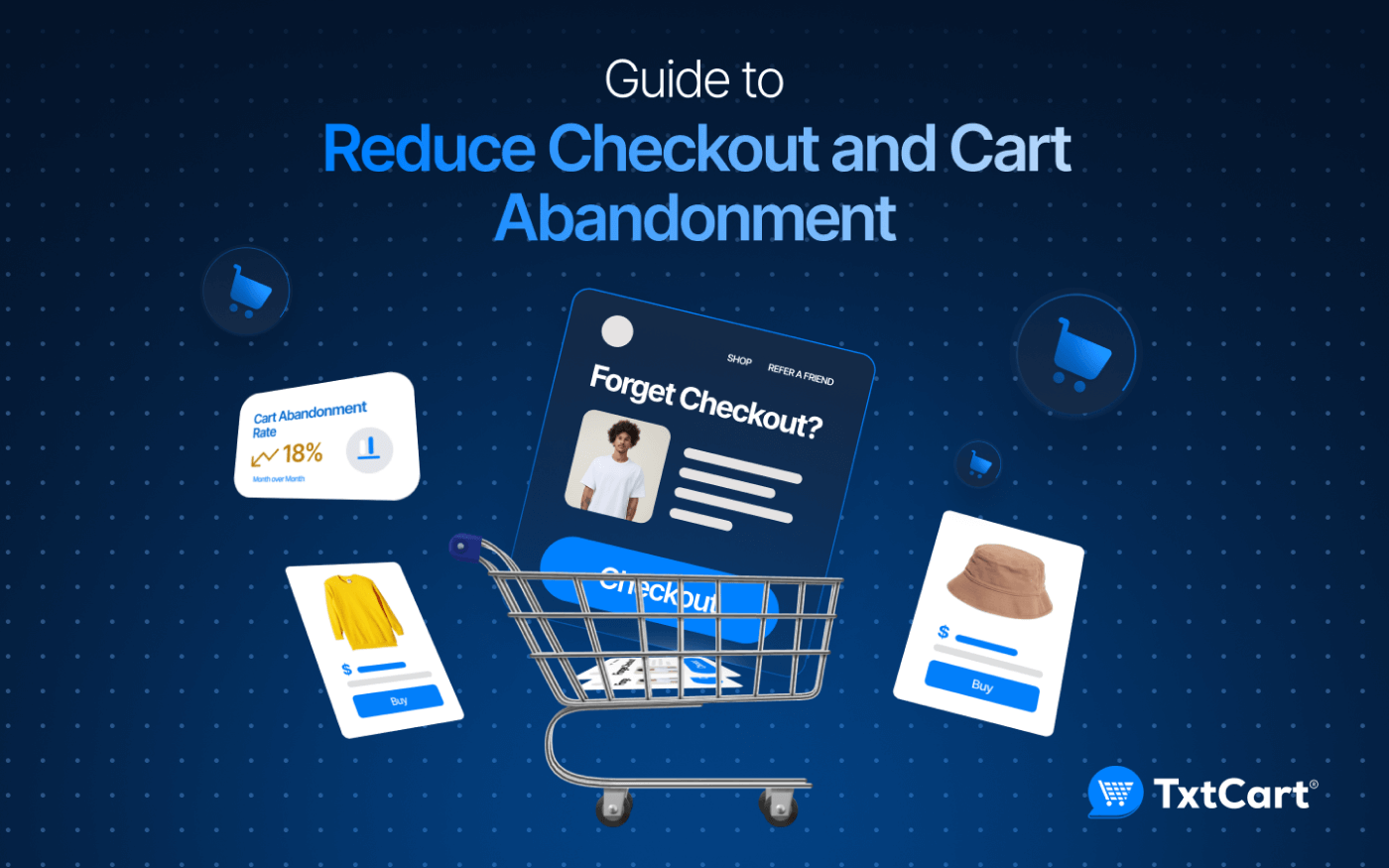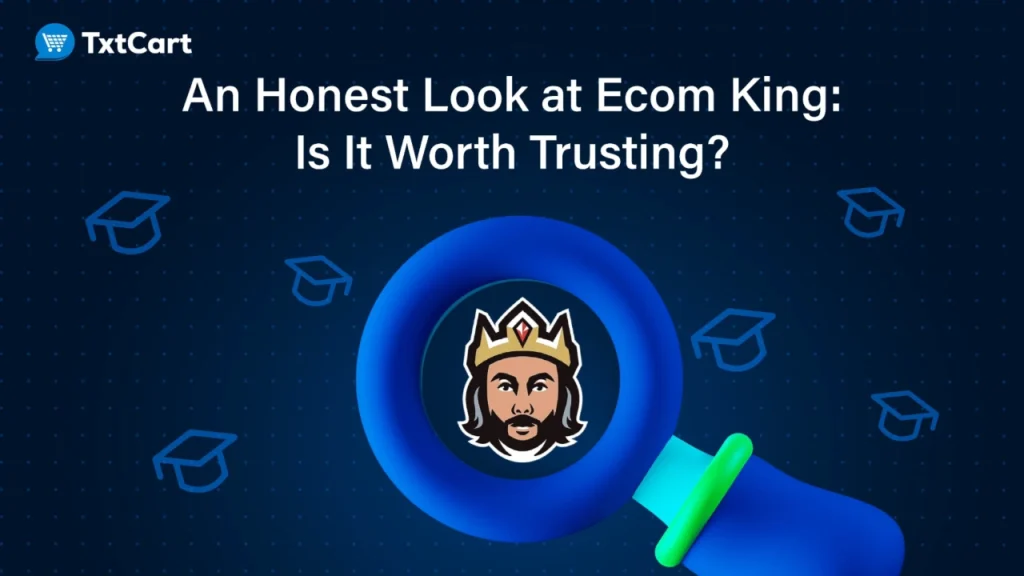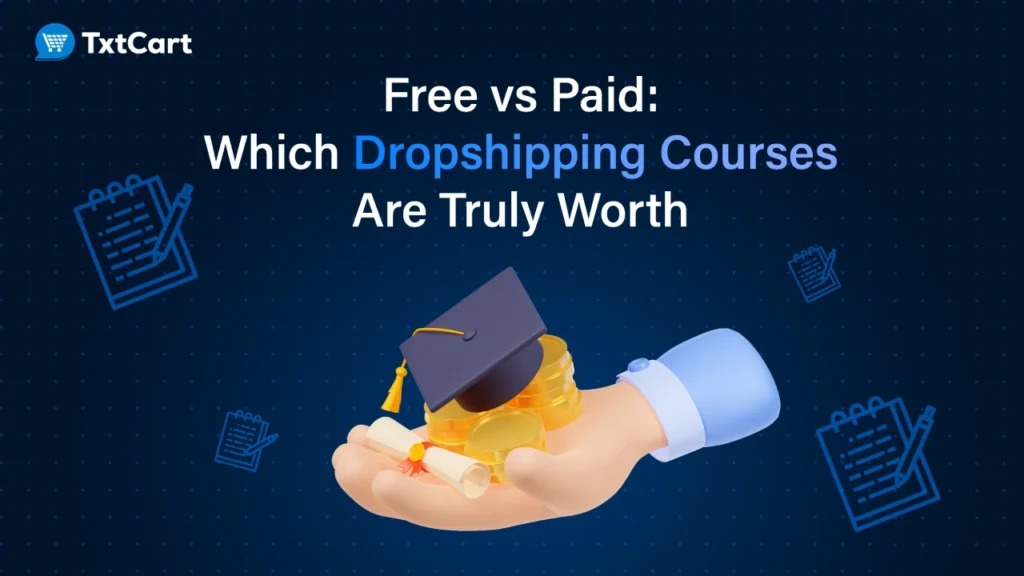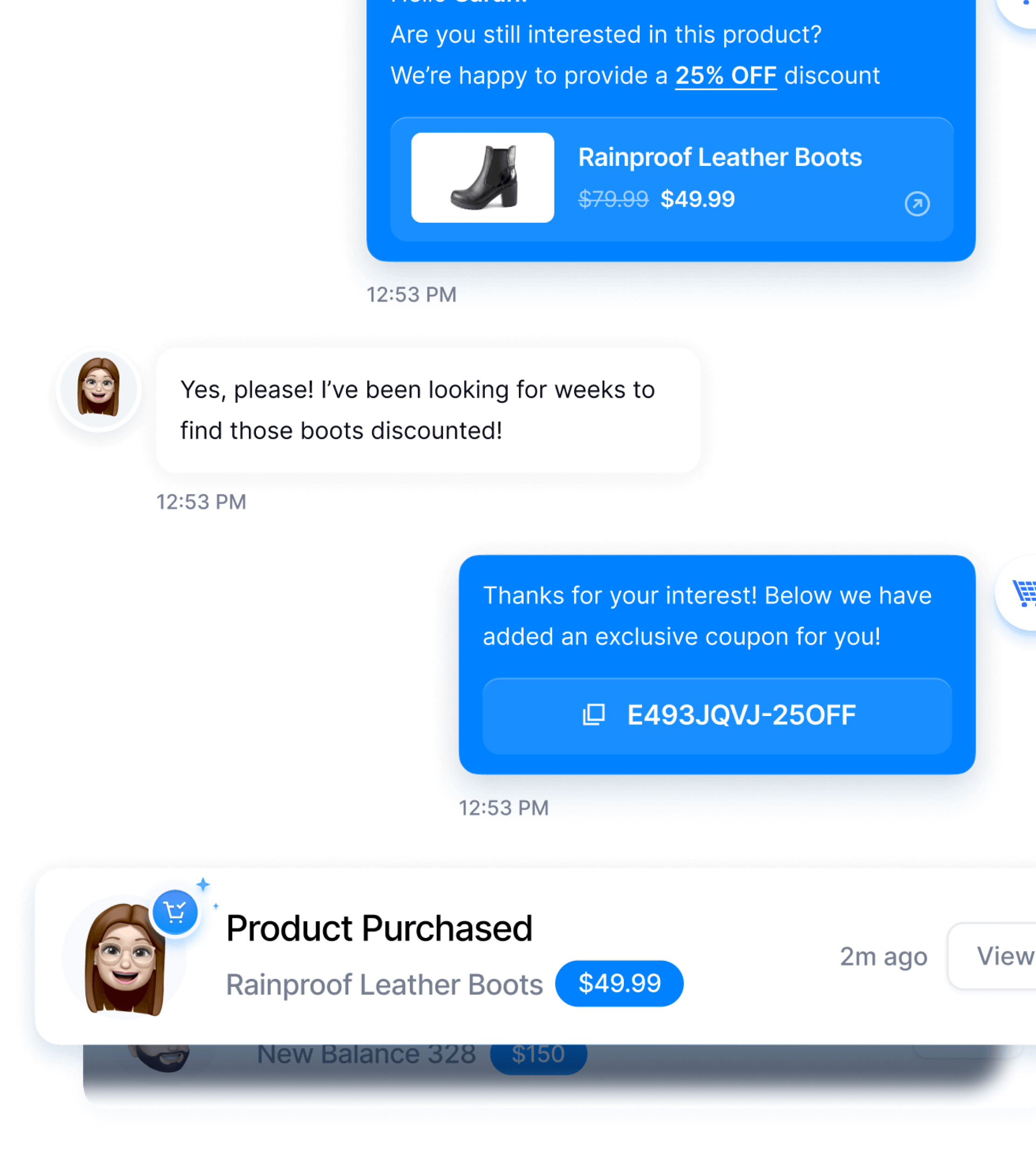Losing sales to abandoned carts?
Don’t worry, we’ve got proven strategies to recover those lost sales and boost your bottom line.
In this guide, we’ll show you how to optimize your sales funnel from start to finish, including:
- Pre-Abandonment: Streamline checkout and build trust.
- Active Prevention: Use pop-ups, live support, and price adjustments.
- Recovery: Master SMS, email follow-ups, and retargeting.
- Tracking & ROI: Measure the effectiveness of your strategies.
Ready? Let’s go.
TL;DR: Slicing Shopping Cart Abandonment Rates in 2025
- Understanding the Problem: High extra costs, mandatory account creation, slow delivery, security concerns, complicated checkout, hidden costs, website issues, poor return policies, limited payment methods, and payment declines are the main reasons for cart abandonment.
- Pre-Abandonment Strategies: Simplify your checkout process, be transparent about costs, and build trust with security badges, reviews, and clear policies before customers abandon their carts.
- Active Prevention Strategies: Use exit-intent popups, offer real-time support (including conversational SMS), and address price sensitivity with discounts and offers while customers are still on your site.
- Recovery Strategies: Implement effective recovery methods such as conversational SMS (using TxtCart), email follow-ups, and retargeting ads to win back lost customers.
- Implementation Guide: Prioritize strategies, allocate resources, create a timeline, and measure your ROI using tools like TxtCart’s analytics.
- Case Studies & Results: Real-world examples show how businesses have successfully used TxtCart to recover abandoned carts and boost revenue.
- Best Practices to Avoid Cart Abandonment: Use push notifications, product thumbnails in carts, easy cart saving, security seals, accessible FAQs, improved UX, fast shipping options, clear return policies, and social proof to enhance conversions.
Why do shoppers abandon carts? (The culprits)
Before we jump into solutions, let’s understand the scope of the problem. Knowing why people abandon carts is critical before formulating solutions.
The latest Baymard Institute research reveals the most common reasons, which we’ve broken down here:
| Culprit | Explanation |
|---|---|
| Unexpectedly high extra costs (shipping, taxes, or added fees) | Nearly half of online shoppers cite surprise costs as their main reason for abandoning a purchase. Hidden charges are a major deal-breaker. |
| Mandatory account creation | Forcing customers to register an account before purchasing is a big turn-off for roughly a quarter of shoppers. This extra step creates unnecessary friction. |
| Unacceptably long delivery times | Slow shipping is a common complaint besides high shipping costs, deterring over one-fifth of potential buyers. Customers expect fast and efficient delivery. |
| Concerns about website security and payment safety | Almost one in five shoppers hesitate to share their credit card details with websites they don’t fully trust. Security is paramount. |
| Overly lengthy or complicated checkout process | A complicated guest checkout experience is a major obstacle, causing almost one-fifth of shoppers to give up. Simplicity is key. |
| Lack of upfront cost visibility | Not being able to easily see the total cost, including all fees, before reaching the final checkout stage frustrates over 15% of buyers. |
| Technical issues or website crashes | Website errors or unexpected crashes lead to abandonment for more than one in ten shoppers. A smooth and reliable ecommerce site is crucial. |
| Unfavorable return policies | Dissatisfaction with return policies discourages over one in ten customers from completing their purchase. A customer-friendly return policy builds trust. |
| Limited payment options | A lack of preferred payment methods causes almost one in ten shoppers to abandon their carts. Providing diverse payment process options is essential. |
| Payment declines | Issues with credit card processing, such as declines, account for a small percentage of abandoned carts. |
Baymard Institute estimates that a staggering $260 billion in lost orders is recoverable in the US and EU solely through better checkout flow and design. If you’re running a Shopify store, or any online store for that matter, understanding these reasons is the first step to reducing cart abandonment and recovering those lost sales.
Toroe Eyewear, a premium performance eyewear brand, used TxtCart’s 2-way SMS to generate $60,382 in revenue, with over 3,400 conversations and a 41.23% reply rate, boosting sales and recovering 800+ orders in 8 months.
$60,382
SMS Attributed Revenue
24.8x
SMS Attributed ROI
800+
Recovered Orders

“Hands down the best SMS Marketing platform we have used thus far. TxtCart allows us to scale our advertising with the profits it generates and has been extremely user-friendly and easy to set up.”
Founder, Toroe Eyewear
Also Read: 8 Hacks to Increase Your Ecommerce Sales Today (Easily)
Now, let’s get to those strategies to reduce shopping cart abandonment.
Grab this cart abandonment checklist before you skidaddle
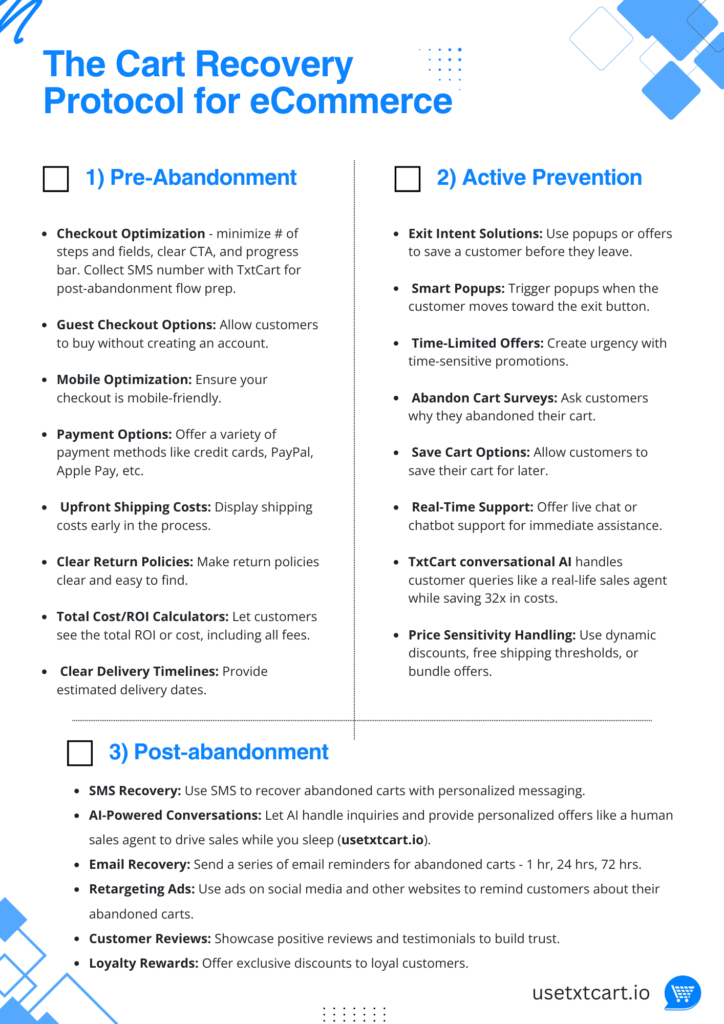
1) Pre-Abandonment Strategies
Before a customer even thinks about abandoning their cart, you have the chance to create a smooth, trustworthy, and enticing shopping experience. This is about optimizing the entire pre-purchase journey to minimize friction and maximize conversions. Think of it as laying the groundwork for a successful sale. We’re talking about making things easy for your customers.
Checkout Optimization for A Seamless Path to Purchase
A complicated or confusing checkout process is a major reason for cart abandonment. Customers want a quick, hassle-free experience. If they hit a roadblock, they’re likely to bounce. It’s like trying to drive through a construction zone—frustrating and time-consuming.
- Guest Checkout Options: Let customers buy without creating an account. This removes a significant barrier, especially for first-time buyers. It’s all about removing friction.
- Progress Indicators: Show customers where they are in the checkout process. This builds trust and reduces anxiety. Nobody likes feeling lost in a maze.
- Mobile Optimization: In today’s mobile-first world, your checkout must be mobile-friendly. A clunky mobile experience is a recipe for disaster. Test your checkout on different devices to ensure it’s smooth and responsive.
- Payment Options: Offer various payment options, including credit cards, debit cards, PayPal, Apple Pay, Google Pay, and even buy-now-pay-later services. The more options you provide, the more likely you are to convert.
Transparency to Build Confidence Through Honesty
Hidden fees and unexpected costs are a huge turnoff. Be upfront and transparent about all costs from the very beginning. This builds trust and prevents last-minute surprises that lead to cart abandonment.
- Upfront Shipping Costs: Display shipping costs early in the process, ideally on the product page or in the cart. Don’t wait until the final checkout page to spring these costs on customers.
- Clear Return Policies: Make your return policy easy to find and understand. A clear and generous return policy can significantly increase customer confidence and reduce purchase anxiety.
- Total Cost Calculators: Provide a tool that calculates the total cost, including shipping, taxes, and any other fees. This gives customers a clear picture of what they’ll be paying.
- Delivery Timelines: Give customers an estimated delivery timeframe. Nobody likes waiting around without knowing when their order will arrive.
Trust Building for Earning Customer Confidence
Building trust is essential for converting browsers into buyers. Customers need to feel confident that their information is safe and that they’re dealing with a reputable business.
- Security Badges: Display security badges from trusted providers like Norton, McAfee, or SSL certificates. These badges reassure customers that their information is protected.
- Customer Reviews: Showcase positive customer reviews and testimonials. Social proof is a powerful way to build trust and credibility.
- Clear Policies: Make sure your privacy policy, terms of service, and other important policies are easy to find and understand. This demonstrates transparency and professionalism.
- Social Proof: Use social media mentions, user-generated content, and other forms of social proof to demonstrate your brand’s popularity and trustworthiness. This can include how many followers you have on social media, or even user-generated content.
This groundwork is crucial. Nail these pre-abandonment strategies, and you’ll see a significant improvement in your conversion rates. It’s all about creating a positive and trustworthy experience from the start.
2) Active Prevention Strategies: Stopping Abandonment in Its Tracks
Let’s discuss actively preventing cart abandonment while the customer is still on your site. These strategies involve anticipating potential objections and providing timely solutions.
Exit Intent Solutions: The Last-Minute Save
Exit-intent technology detects when a user is about to leave your website and triggers a targeted message or offer. This is your last chance to grab their attention and persuade them to stay.
- Smart Popups: Use popups that appear when a user’s cursor moves toward the browser’s exit button. These pop-ups can offer a discount, free shipping, or other incentives to encourage them to complete their purchase. Don’t be annoying with these. Make sure they are timed well and offer real value.
- Time-Limited Offers: Create a sense of urgency with time-limited offers. This can be a discount that expires within a certain timeframe or a limited-time promotion. This can be very effective at pushing people over the edge to purchase.
- Abandon Cart Surveys: Ask departing customers why they’re leaving. This provides valuable insights into their reasons for abandoning their carts and helps you improve your overall checkout process. This is a great way to get direct feedback from your customers.
- Save Cart Options: Allow customers to save their carts for later. This is especially useful for customers who aren’t ready to purchase immediately but want to save their items for future consideration. This is a simple but effective way to prevent immediate abandonment.
Real-Time Support: Being There When They Need You
Offering real-time support can significantly reduce cart abandonment by addressing customer questions and concerns immediately. It’s like having a helpful salesperson available to assist customers throughout their shopping journey.
- Live Chat Integration: Integrate live chat on your website to provide instant support to customers. This allows them to ask questions, resolve issues, and get help with their purchase in real-time.
- AI Chatbots: Implement AI chatbots to handle basic inquiries and provide quick answers to common questions. This can free up your human support team to handle more complex issues.
- Conversational SMS Support: Offer SMS support as another way for customers to reach you. This is especially useful for mobile users who prefer texting over other communication methods. This is where TxtCart really shines. Using TxtCart’s Conversational AI, you can set up automated, human-like responses to common questions, provide personalized support, and even offer exclusive deals through SMS. This is a great way to build relationships with your customers and increase conversions.
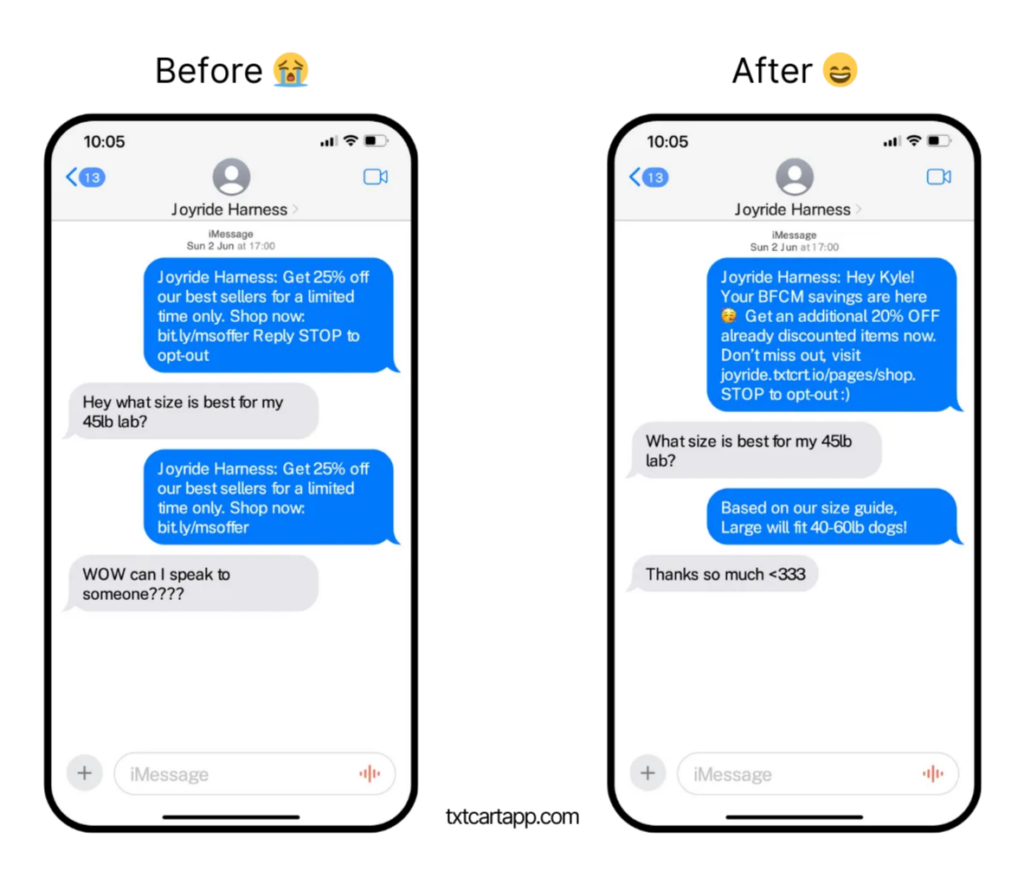
- Human Support Options: Ensure you have human support options available for customers who need more personalized assistance. This can be through phone, email, or live chat.
Chaser, an LA-based fashion brand, leveraged TxtCart’s 2-way SMS to generate $207,341 in revenue, with over 10,983 customer conversations and a 42.78% reply rate, resulting in 1,100+ orders generated.
$207,341
SMS Attributed Revenue
10.8x
SMS Attributed ROI
1,100+
Orders Generated

“Kyle and Hunter have been absolutely outstanding to work with and the platform has exceeded expectations. The ROI has been amazing and I’m excited for the future!”
CEO, Chaser Brand
Must Read: How to Send Personalized Text Messages That Sell
Price Sensitivity Handling to Address Cost Concerns
Price is often a major factor in cart abandonment. Offering strategic discounts, free shipping, and other incentives can help overcome price objections and encourage customers to complete their purchase.
- Dynamic Discounts: Offer dynamic discounts based on customer behavior, such as exit intent or cart value. This can be a powerful way to incentivize purchases.
- Free Shipping Thresholds: Offer free shipping on orders over a certain amount—no unexpected shipping costs. This encourages customers to add more items to their cart to qualify for free shipping.
- Bundle Offers: Offer bundle deals or discounts for purchasing multiple items. This can increase average order value and reduce cart abandonment.
- Loyalty Rewards: Implement a loyalty program to reward repeat customers with exclusive discounts and other perks. This will encourage customer retention and reduce cart abandonment.
These active prevention strategies are all about being proactive and anticipating customer needs. Implementing these tactics can significantly reduce cart abandonment and boost your sales.
3) Recovery Strategies for Bringing Back Lost Customers
Even with the best pre-abandonment and active prevention strategies, some carts will still be abandoned. That’s where abandoned cart recovery strategies come in. This is your chance to win back those lost customers and turn a potential loss into a win. It’s like offering a second chance—and making the most of it.
The Power of SMS for Recovering Abandoned Carts
The following are high-profile case studies of eCommerce stores leveraging SMS marketing. They combat cart abandonment and drive sales by handling customer objections and sending personalized offers that sound eerily human with TxtCart’s conversational AI – all while remaining TCPA compliant.
Honestly like a money printer for us…
“Within the first 45 days we’ve been able to add an additional $8,500 in revenue to our bottom line with only a small list of SMS subscribers.”
Gamenetics™
TxtCart Customer on the Shopify Marketplace
Read next: What is SMS Remarketing? Top Strategies & Best Practices
Here are some cases in point:
- Organi Grow Hair (vegan haircare): Leveraging TxtCart’s two-way SMS, Organi achieved a 16.9x ROI, recovered $25K per month, and secured over 9,500 personalized campaign orders. Their success stemmed from a combination of high reply rates (42%) and effective engagement strategies.
- Haute Home LA (luxury home decor): Within the first 5 days of using TxtCart, Haute Home LA generated a staggering $15,000 in sales. Their 37.5% reply rate and high average order value ($1,937) translated into $40,695 in revenue within 30 days. This showcases the immediate impact TxtCart can have on driving sales.
- Joyride (dog harness brand): Joyride capitalized on TxtCart’s two-way SMS to recover abandoned carts and achieve remarkable results. They generated a whopping $1,841,617 in SMS-attributed revenue, facilitated 23,616 sales, and fostered over 2.8 million customer conversations. This highlights the power of TxtCart in fostering long-term customer relationships.
- CROSSNET (sports brand): Over 8 months, CROSSNET utilized TxtCart’s SMS capabilities to generate $453,185 in revenue, recover over 3,000 orders, and engage in 5,389 customer conversations. This case study demonstrates the platform’s effectiveness in driving consistent revenue growth.
Also Read:
Conversational SMS Recovery to Reconnect Through Text
SMS is a powerful tool for recovering abandoned carts. It’s direct, personal, and has a high open rate. This is where TxtCart truly shines because it doesn’t send your typical robotic reminder. It starts a human-like conversation that drives sales while you sleep.
Here’s how TxtCart helps you recover abandoned carts through conversational SMS:
- AI-Powered Conversations: TxtCart’s AI can handle customer inquiries, drawing information from a knowledge base you control. This means quick, accurate answers, available 24/7. This is much more effective than simply sending a robotic reminder.
- Personalized Messaging: TxtCart lets you personalize your SMS messages with the customer’s name, the items in their cart, and even special offers. This makes the message feel more personal and less like a generic blast.
- Response Handling: Unlike other platforms that just send one-way messages, TxtCart facilitates two-way conversations. If a customer replies with a question or concern, you can address it directly through SMS. This is key to converting those abandoned carts.
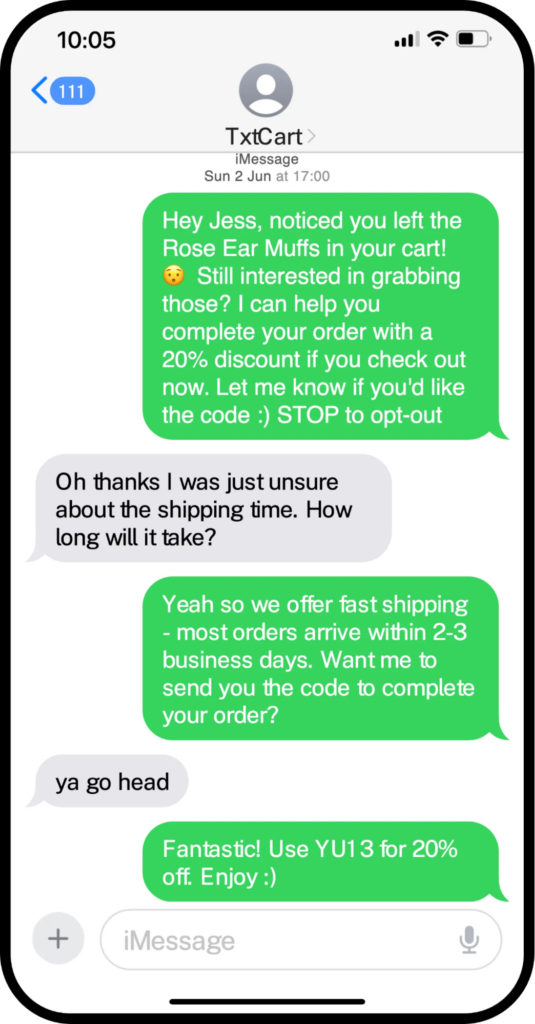
- Success Metrics: Track key metrics like click-through rates, conversion rates, and recovered revenue to measure the effectiveness of your SMS recovery campaigns.

Want to try conversational SMS for free?
Drive more sales with intelligent AI-driven automations that recover carts, engage customers, and streamline flows — saving you 32x in costs. No contracts or minimums.
- Try free for 14 days
- 10x ROI guaranteed
- Join 3000+ Shopify brands
Read Next:
- Conversational SMS Guide: 15+ Best Examples, Uses, & Tips
- 50+ SMS Templates for eCommerce That Simply Work
Email Recovery
Email is another effective way to recover abandoned carts. It’s less immediate than SMS but allows for more detailed messaging and visual content.
- Timing Sequences: Send a series of emails at strategic intervals. A common approach is to send the first email within an hour of abandonment, the second email 24 hours later, and the third email a few days later.
- Content Strategies: Use compelling subject lines, personalized messaging, and clear calls to action. Include images of the abandoned items and highlight any special offers or discounts.
- Performance Metrics: Track open rates, click-through rates, and conversion rates to measure the success of your email recovery campaigns.
Retargeting to Bring Them Back with Ads
Retargeting involves showing ads to customers who have previously visited your website or abandoned their carts. This keeps your brand top-of-mind and encourages them to return and complete their purchase.
- Social Media Ads: Use social media platforms like Facebook and Instagram to retarget customers with ads featuring the items they abandoned.
- Display Advertising: Use display ads on other websites to retarget customers who have visited your site.
- Cross-Channel Coordination: Coordinate your retargeting efforts across different channels, such as social media, email, and SMS, for a more comprehensive approach.
- Budget Allocation: Allocate your advertising budget strategically to maximize your ROI.
These recovery strategies are about maximizing every opportunity to win back lost customers. You can significantly increase your conversion rates and boost your bottom line by using a combination of SMS, email, and retargeting.
Remember, tools like TxtCart make the SMS recovery process much simpler and more effective, thanks to its conversational capabilities and AI.
Implementation Guide: Putting It All Together
Now that you have a solid understanding of the strategies, let’s discuss implementing them. We will create a plan, allocate resources, and measure success. This is where the rubber meets the road.
- Strategy Prioritization: You don’t have to implement every strategy at once. Start by prioritizing the ones that are most likely to have the biggest impact on your business. Consider your current average cart abandonment rate, your target audience, and your available resources. For most ecommerce businesses, focusing on checkout optimization and recovery strategies (especially SMS and email) will yield quick wins.
- Resource Allocation: Determine what resources you need to implement your chosen strategies. This includes budget, time, and personnel. If you’re using tools like TxtCart, factor in the cost of the platform and any necessary training. Consider who on your team will be responsible for each task.
- Timeline Planning: Create a realistic timeline for implementing your strategies. Break down each task into smaller, manageable steps and assign deadlines. This will help you stay organized and on track. Don’t try to do everything at once. Start with a few key strategies and then build from there.
- ROI Measurement: Measuring your ROI is crucial for determining the effectiveness of your online shopping cart abandonment strategies. This is where TxtCart’s Campaign & Revenue Analytics comes in handy.
Additional Best Practices to Avoid Cart Abandonment
Now, let’s explore some additional best practices that can further enhance your efforts. These are the extra touches that can make a big difference.
- Send push notifications: For mobile users who have opted in, push notifications can be a timely reminder of their abandoned cart. These are great for reaching customers on their mobile devices.
- Include product thumbnails in the cart: Displaying images of the items in the cart helps reinforce the purchase decision and reminds customers what they’re about to buy. It’s a simple visual cue that can be surprisingly effective.
- Make Saving Carts Easy: Allowing customers to easily save their carts for later is a great way to accommodate those who aren’t ready to purchase immediately. This prevents immediate abandonment and allows them to return at their convenience.
- Show Security Seals: Prominently displaying security badges and SSL certificates builds trust and reassures customers that their information is safe. This is especially important during the checkout process.
- Answer Questions: Provide easy access to FAQs, contact information, or live chat support to address any customer questions or concerns. This proactive approach can prevent hesitation and encourage conversions.
- Improve User Experience: A smooth, intuitive website design and customer journey are crucial for minimizing frustration and encouraging purchases. Make sure your site is easy to navigate, loads quickly, and is mobile-friendly.
- Provide Fast Shipping Options: Offering expedited shipping options can be a strong incentive for customers who need their items quickly. This can be a deciding factor for some shoppers.
- Highlight Easy Returns & Money-Back Guarantees: Clearly communicate your return policy and any money-back guarantees. This builds trust and reduces purchase anxiety.
- Convince Shoppers With Social Proof: Showcasing testimonials, reviews, and social media mentions can build trust and influence purchase decisions. This is a powerful way to leverage the opinions of other customers.
When combined with the core strategies we’ve discussed, these additional best practices create a comprehensive approach to reducing cart abandonment and maximizing your online sales. It’s about creating a seamless, trustworthy, and enticing shopping experience that encourages customers to complete their purchases.
Ready to Reclaim Your Lost Revenue? SMS is KING.
Reducing cart abandonment is an ongoing process, not a one-time fix. By implementing these strategies—from optimizing your checkout to mastering recovery—you’ll create a better customer experience and boost your bottom line. It’s about making it easy for customers to buy from you and then reminding them gently if they forget.
Here’s a quick recap of the key takeaways:
- Optimize your checkout: Keep it simple, fast, and mobile-friendly.
- Be transparent with costs: No hidden fees or surprises.
- Build trust: Use security badges, reviews, and clear policies.
- Use active prevention: Employ pop-ups, real-time support, and price incentives.
- Master recovery: Leverage SMS, email, and retargeting.
If you’re serious about recovering abandoned carts and want a powerful, easy-to-use tool, check out TxtCart. It’s designed specifically for ecommerce businesses and makes conversational SMS recovery a breeze. It’s a great way to turn those lost opportunities back into revenue.
Joyride, an LA-based dog harness brand, leveraged TxtCart’s 2-way SMS to generate $1,841,617 in revenue, with 23,616 sales generated and over 2.8M customer conversations, driving massive growth in their eCommerce operations.
$1,841,617
SMS Attributed Revenue
12.4x
SMS Attributed ROI
23,616
Sales Generated
“Kyle and the team at TxtCart have been instrumental in our growth. They’ve worked closely with us to create custom solutions and the results have been phenomenal. TxtCart has helped us scale significantly and provided support at every turn.“
Founder, Joyride
Read Next:
